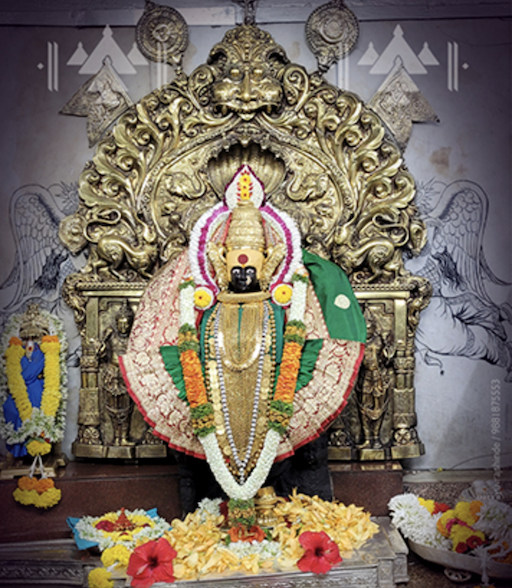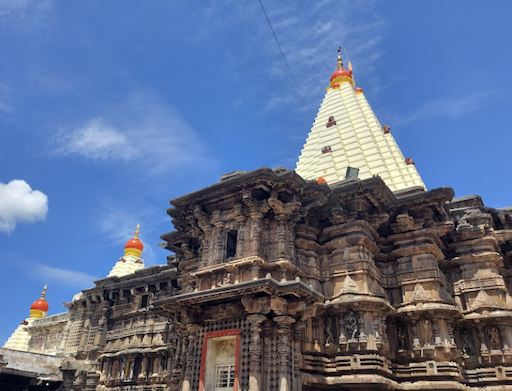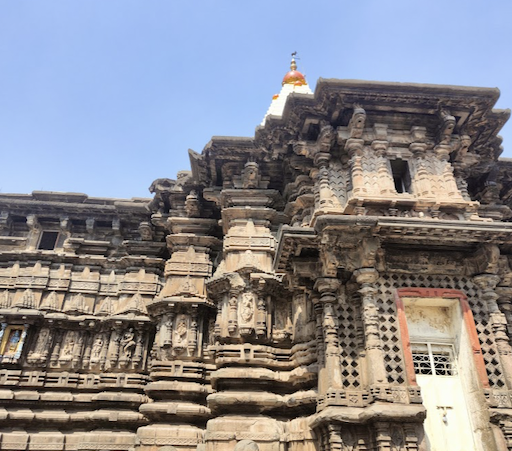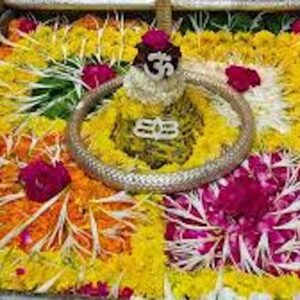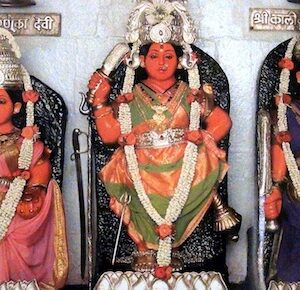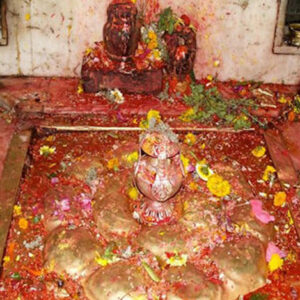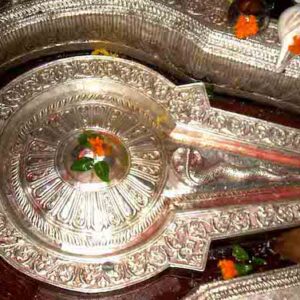This is a consecrated temple of Shri Mahalaxmi Ambabai.
There is a place to sit and meditate. You can go into meditative states here effortlessly.
How to Get there
The temple is 3 kms West of Kolhapur Bus Stand.
Map:
https://maps.app.goo.gl/bu6B5TmEL29vWE7B9
About Shri Mahalaxmi Ambabai
It is said that Man created God in his own image. How true! Man has attributed all the features of a human body to the Gods and Goddesses. He has also gone further to attribute several other characteristics to the divinities that are not found in human beings. It is fascinating to learn how Man created idols and statues of Gods and Goddesses. It is a process that started from a belief in Shakti (infinite energy) and culminated in the idol worship that conferred various forms to that infinite energy.
About Shri Ambabai/Mahalaxmi Temple
In early days, this Shakti was witnessed in the form of five basic elements of Prithvi (earth), Aap (water), Tej (light), Vayu (wind), Akash (space). When Man pondered over his birth and the person responsible for it, he realized that mother is at the root of the genesis, and it is she who embodies the Shakti . He aspired to give a finite structure to the infinite energy. In the process he first named that finite structure as Matruka (representation of energy in the form of a divine mother). Then he granted a shape to the Matruka. The earliest form was of Pashan1 or Tandula2 (stone) and Varula (ant hill).
The main places where such Mahamatruka (the great divine mother) were established came to be known as Mahamantrukasthan (abode of the great divine mother). Such sites were discovered all over India. In Maharashtra they were identified in Kolhapur, Tuljapur, Mahur and Vani. All the four were thus called the Shaktipeeths (seat of the Goddesses that embodies energy). These places then became popular as pilgrimage sites.
The finite form of the Goddess was further refined by Man. The birth of the universe and in turn his own birth had intrigued him. He wished to give a better representation to the Shakti. Therefore the mere stone representation was improvised to the form of Lajjagauri (female figure with a prominent womb). Lajjagauri was intially a two dimensional figure.
As years passed Shakti that was represented by Paravati3 and Durga4 was also manifested in three different forms namely Mahalakshmi, Mahakali and Mahasaraswati. “The framing narrative of Devi Mahatmya Presents a dispossessed king, a merchant betrayed by his family, and a sage whose teachings lead them both beyond existential suffering. The sage instructs by recounting three different epic battles between the Devi (Goddess) and various demonic adversaries the three tales being governed by, respectively, Mahakali, Mahalakshmi and Mahasaraswati. Goddess Mahalakshmi is the presiding Goddess of the middle episode. Here she is depicted as Devi in her universal form as Shakti. The world was under attack by Mahishasura the most evil demon in the world, who took many different forms, including that of a buffalo. The male Gods, fearing total annihilation endowed Durga with their powers. The Goddess is described as eighteen- armed bearing string of beads, battle axe, maze, arrow, thunderbolt, lotus, bow, water-pot, cudgel, lance, sword, shield, conch, bell, wine-cup, trident, noose and the discus sudarsana. She has a complexion of coral and is seated on a lotus. She is known as Ashta Dasa Bhuja Mahalakshmi. Riding a lion into battle, she slew the buffalo by cutting off its head and then she destroyed the spirit of the demon as it emerged from the buffalo’s severed neck. It is through this act that order was established in the world”. Eventually the abovementioned description of Goddess Mahalakshmi was manifested in the form of idols. The evolution was gradual. The two dimensional concept of Lajjagauri developed in to a three dimensional form when art of idol making was initiated. Thus the statues of Goddesses in various avataras8 of Durga were created. From 500 B.C. to 300 A. D. Buddhism and Jainism had a major influence on the Indian population. This was the era when cave architecture, cave paintings and cave sculptures flourished. Monks, merchants and travelers in that era preferred the safety of the caves, that were pre-dominantly on hills and mountains to protect themselves from wild beasts and other natural forces. It was during the Buddhist period that idol making saw the light of the day. Yet not many temples were found in those times. Later as human settlements mushroomed rapidly along rivers and seaside, Vedic culture9 was given a boost by the political heads of that era and temples came into being.
From2nd to 5th century A. D. foreign rulers like Shaka, Kshatrap and Nag Dynasty held sway in some parts of India. These forces were destroyed by Kings Samudragupta, Chandraputa II Vikramaditya, Kumargupta, Skandhgupta of the Gupta Dynasty. In fact, King Shrigupta married a lady from Lichchavi Dynasty and kicked off the Gupta Rule in India. Further on Vikramaditya defeated the foreign rulers like Shaka and Kshatrap to establish local independent rule. This change in political leadership revived the Vedic culture. India by then was united under one political head who revered Lord Vishnu. This era that lasted from 300 to 500 A. D. saw the dawn and rise of Bhagwat Cult in India. This Cult entails worship of Vishnu and his consort Lakshmi. This was also the phase when temples began to be contracted in India.
The Vedic culture encouraged religious literature and establishment of pilgrimage sites Through the religious literature we can understand the form Of Mahalakshmi as it is seen today Legend says that Gods and demons churned the ocean and certain jewels were born. Lakshmi was one among them. As soon as she emerged she became the consort of Lord Vishnu who is one of the three Gods that form the Holy Trinity (Bramha, Vishnu, Mahesh). This Goddess with unparallel beauty was a female representation of Universal wealth. Eight forms of Goddesses dwell within her, Dhanalakshmi (provides wealth), Dhaanyalakshim (provides crops), Dhairyalakshmji (provides courage), Shauryalakshmi (provides valour), Kirtilakshmi (provides fame), Vinayalakshmi (instills modesty), Raajyalakshmi (provides kingdom) and Santaanlakshmi (provides children). She signifies property, happiness, radiance and fame.
It is believed that the first mention of Goddess Mahalakshmi was found in 250 B. C., and the first form of Goddess Mahalakshmi is that of Gajalakshmi, Lakshmi bedecked with jewellery seated on lotus and flanked by two white elephants, seen on stupas constructed by Emperor Ashoka in Sanchi and Bodh Gaya. Some scholars opine that his form was derived from figures of Goddess Mayavati in Budhdhist caves and figures of Goddess Padmavati in Jain caves and temple that come in to being in 1st century A.D.
The Gupta kings, known to be devotees of Vishnu and Lakshmi have depicted Lakshmi on their coins in various poses. Several coins of this era show Lakshmi and Garud (the eagle which is Vishnu’s vehicle), Lakshmi bedecked with jewellery astride a lion, Lakshmi astride a peacock, Lakshmi seated on an expanded lotus, Lakshmi seated on a throne etc. The Gupta Dynasty accepted Lakshmi in the form of Raajlakshmi (who blesses the kingdom) and Vaibhavlakshmi (who brings about prosperity). One of the descriptions of the coin states, “Halo around the goddess head, her pearl diadem, ear-pendants, necklace, bangles & armlets clearly to be seen, she holds noose in her extended r. hand and lotus seat prominent, Symbol on l. Legend on r.partly damaged”.
After the Gupta Kings, Goddess Mahalakshmi received royal patronage by Chalukya, Rashtrakuta, Shilahara and Yadava Dynasties. Goddess Mahalakshmi was consecrated in various temples during 4th and 5th century A.D. The temple of Goddess Mahalakshmi in Kolhapur which was first constructed in the Chlukya Era has an idol of the deity that has been sculpted with four arms, wearing a saree in Karnataka style. Worship of Mahalakshmi continued over several centuries. Swami Chakradhar of Mahanubhav Sect wandered all over India in 12th Century A.D. In his notes, he mentions that there were 27 temples of Mahalakshmi in that era. The idols in these temples seem to be of the same style as that found in Kolhapur. It was in this epoch that temples of Mahalakshmi were built in Anhilwada in Gujarat, In Dogadvallis in Karnataka and Anantpur in Telangana. King kadamba of Goa also worshipped Goddess Mahalakshmi.
In several inscriptions names like Ramaa, Bhavani and Lakshmi have been used for Mahalakshmi. A stone inscription dated 24 December, 1049 found in Shirur Taluka in Maharashtra mentions that the grants were given by King Marasingh Prabhu descendent of Prabhu Rajaverman, Devotee of Goddess Mahalakshmi of Kolhapur. The inscription describes Goddess Mahalakshmi of Kolhapur as Sinhavahini (Goddess astride a lion) and Rudraardhangotsanga Nivasini, (Shiva’s consort).” Little wonder that Goddess mahalakshmi is considered as second avatar of Durga.
The Shri Ambabai/Mahalaxmi Temple of Kolhapur in Maharashtra, India,
The Shri Ambabai/Mahalaxmi Temple of Kolhapur in Maharashtra, India, is one of the three and half Shakti Peethas listed in various puranas of Hinduism. According to these writings, a Shakti Peetha is a place associated with Shakti, the goddess of power. The Kolhapur Shakti Peetha is of special religious significance being one of the six places where it is believed that one can either obtain salvation from desires or havethem fulfilled.
About Shri Ambabai/Mahalaxmi Temple
The temple takes its name from Ambabai/Mahalaxmi,and it is believed that the divine couple reside in the area.The temple belongs architecturally to the Chalukya empire and may have been first builtin circa 700 AD. Mounted on a stone platform, the image of the four armed and crowned goddess is made of sandstone.The image of Mahalaxmi carved in black stone is 2feet 8.5 inches in height. The Shri Yantra is carved on one of the corner oposite to mahakali in the temple primises. A stone lion, the vahana of the goddess, stands behind the statue. The Sanskrit inscription on a stone tablet in the wall of the house of Annacharya Panditrao, now in the town hall museum says,”The great Kind Bhojadeva was reigning peacefully with pleasing conversation at Panhala; in 1190. He with a view to ensure the prosperity of his king-dom, The crown contains an image of the nag ling and yoni,the symbols of kal (the time) purush (the creater) and prakruti (the origin of universe) — . In Her four hands, the deity of Ambabai holds objects of symbolic value. The lower right hand holds a mhalunga (a citrus fruit), in the upper right, a large mace (kaumodaki) with its head touching the ground, in the upper left a shield (khetaka), and in the lower left, a bowl (panpatra). Unlike most Hindu sacred images, which face north or east, the image of this deity looks west (Pashchim). sunrays came directly from mahadwar in evening , the rays of the setting sun falls on the face of the idole for three days (31 january 01 02 february and 09,10,11 november. There are a number of other shrines in the courtyard to the datta mandir dkpalmandap, Navagrahas, Surya, Mahishasuramardini, Vitthal-Rakhmai, krishna, panchanganga & swami smarth dashavartar , Ram mandir, sheshashai , Mahavishnu,Hanuman ,Laxmi-narayan ,Khandoba ,Atibaleshwar ,krishna , kalbhairav ,Sidhivinyak ,Sinhwahini ,Tulja Bhavani ,Indrashabha ,Ek mukhi datta. Some of these images date back to the 11th century, while some are of recent origin. Also located in the courtyard there was the temple tank Manikarnika Kund, near datta mandir now there is a garden.
Read More
https://www.mahalaxmikolhapur.com/shri-ambabai-mahalaxmi-mahima.php
https://www.mahalaxmikolhapur.com/about-temple.php
